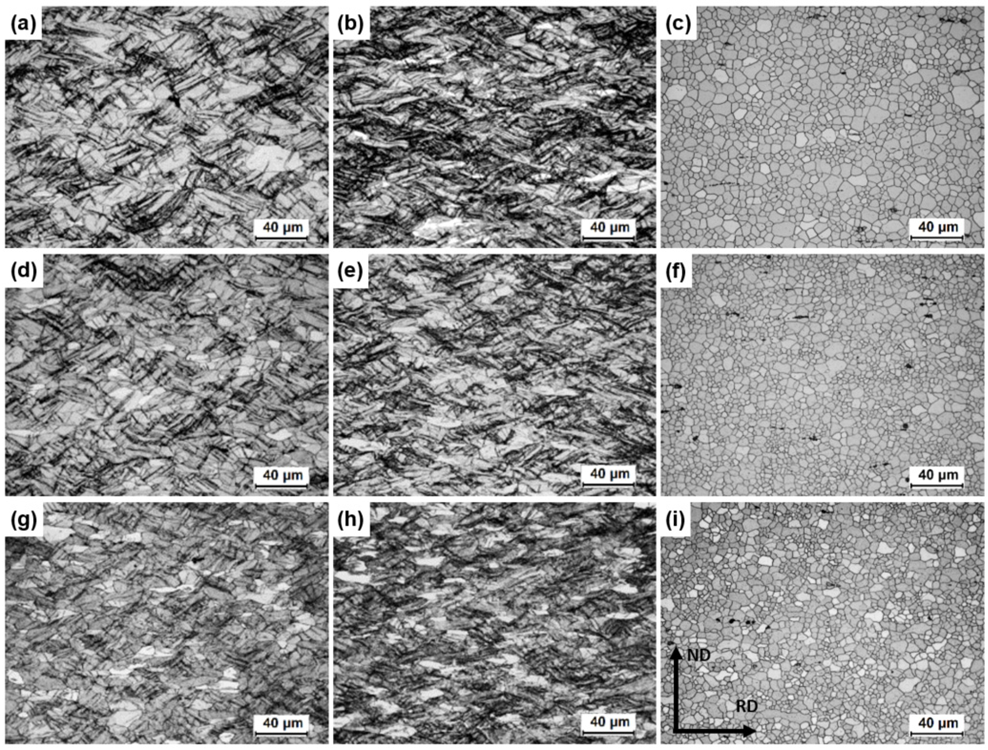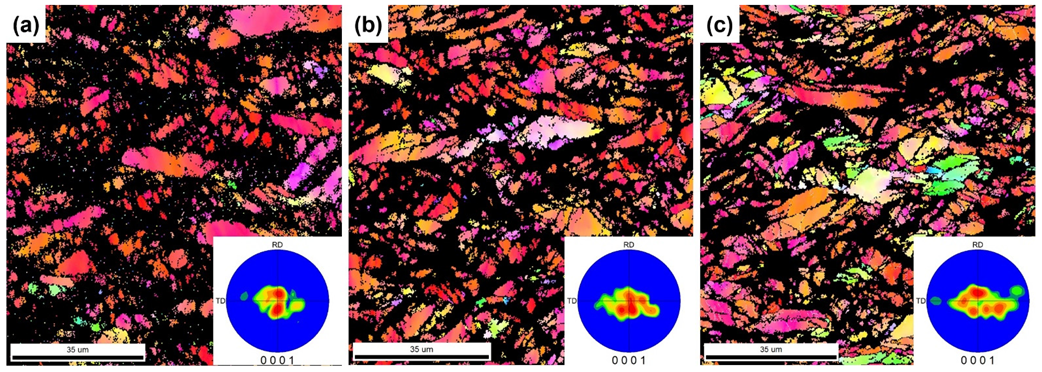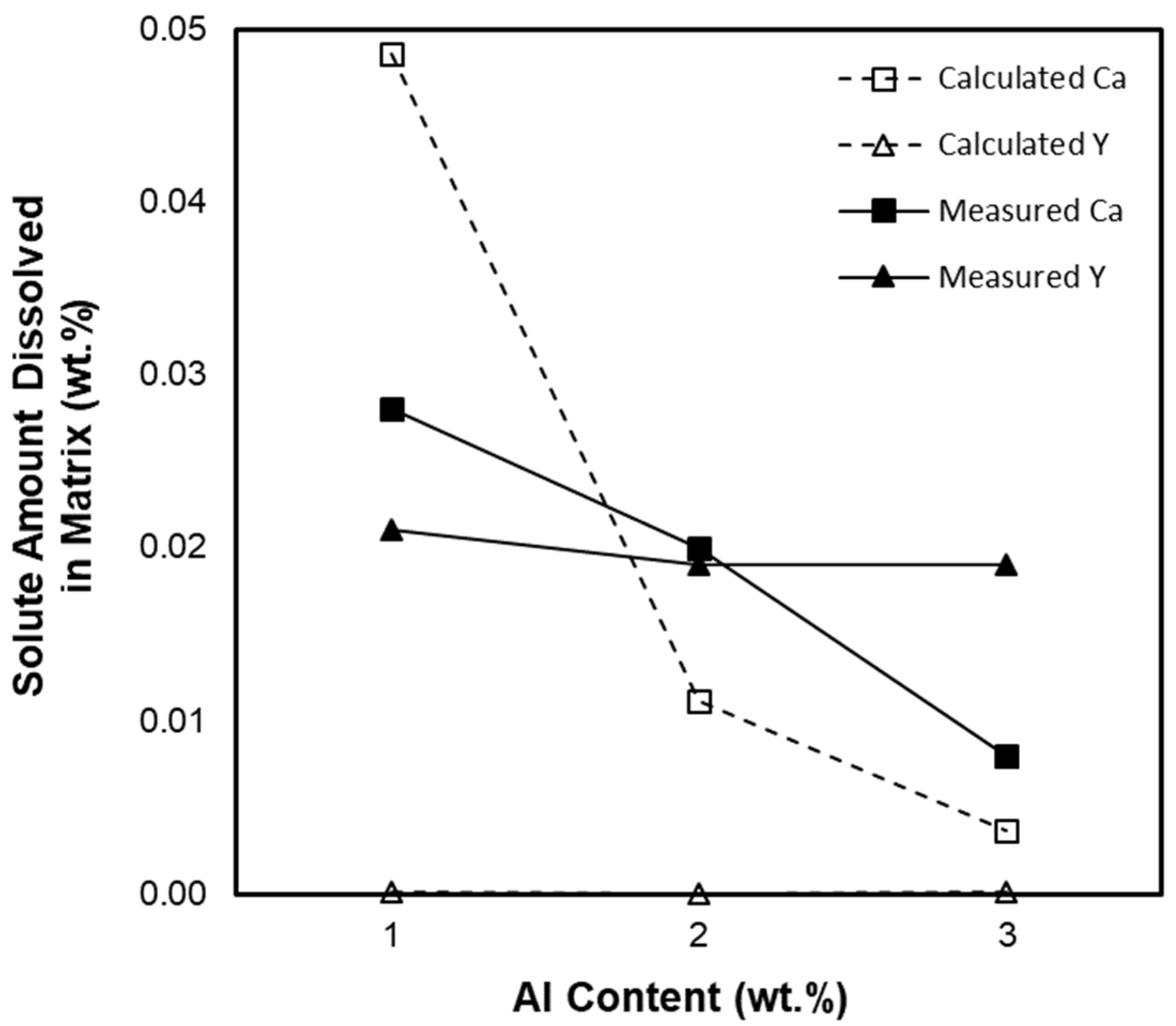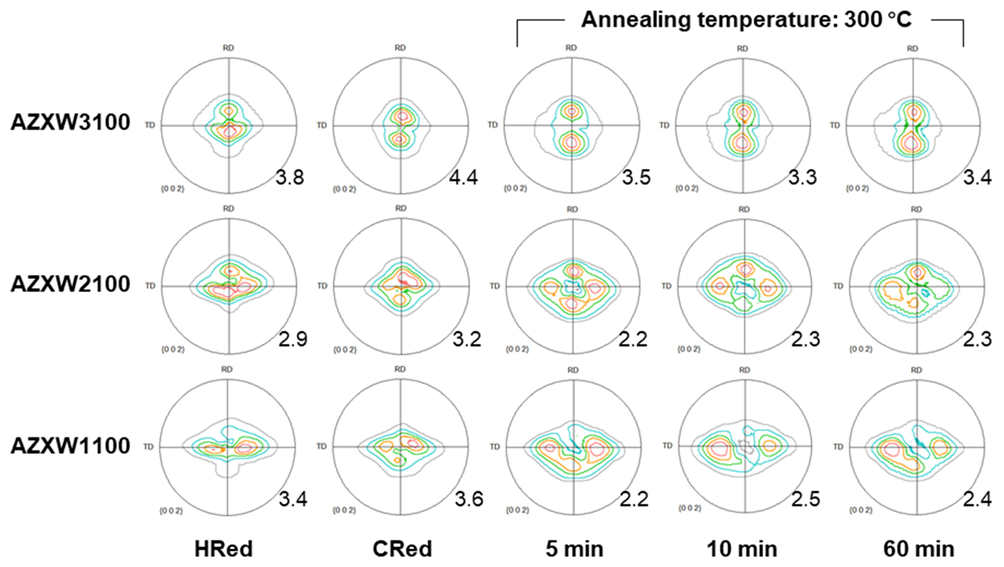Effects of the Al Content on the Evolution of Quadruple Basal Textures in Mg-xAl-1Zn-0.1Mn-0.1Ca-0.2Y Alloy Sheets Processed via Cold Rolling and Annealing
Abstract
:1. Introduction
2. Materials and Methods
3. Results and Discussion
3.1. Microstructural Changes with the Varying Al Content
3.2. Effect of the Al Content on the Texture Evolution
3.2.1. Texture Changes Due to Rolling and Annealing
3.2.2. Variation in the Basal Pole Intensity with the Al Content
3.2.3. Schmid Factor for Basal Slip
4. Conclusions
- (1)
- A decrease in the Al content resulted in a decrease in the basal pole intensity of the annealed sheets along the RD, but there was no significant change in intensity along the TD. In particular, two peaks of basal poles were developed at a specific tilt angle of ±40° to the TD from the ND in the alloys containing 2 and 1 wt.% Al. Consequently, the basal pole figure shape of the annealed sheets gradually changed from RD-split to diamond and TD-split, owing to the relative peak intensities in the RD and TD directions.
- (2)
- The texture change with the Al content in the alloys investigated in this study was mainly attributed to the change in the amount of Ca solute dissolved in the matrix grains. It was confirmed that the addition of a smaller amount of Al led to a larger amount of free Ca solute atoms available to contribute to co-segregation with Zn, resulting in the strengthening of the TD-split texture components but weakening of the RD-split components. Based on the thermodynamic calculation results, the critical amount of Ca solute required to form the TD-split texture component is 0.008 wt.%.
- (3)
- The average SF, which represents the ease of basal slip activation according to the loading direction, has a linear relationship with the maximum intensities of the basal poles along the RD and TD. In this study, as the maximum intensity of the basal poles in the alloys with off-basal textures increased, the average SF of the basal planes increased, making basal slip easier. Considering the average SF, strengthening the intensity of the basal poles developed at a specific tilt angle of ±40° to the TD is more effective in improving the ductility and formability than in those developed at a tilt angle of ±25° to the RD.
Author Contributions
Funding
Institutional Review Board Statement
Informed Consent Statement
Data Availability Statement
Conflicts of Interest
References
- Wang, Q.; Jiang, B.; Tang, A.; Fu, J.; Jiang, Z.; Sheng, H.; Zhang, D.; Huang, G.; Pan, F. Unveiling annealing texture formation and static recrystallization kinetics of hot-rolled Mg-Al-Zn-Mn-Ca alloy. J. Mater. Sci. Technol. 2020, 43, 104–118. [Google Scholar] [CrossRef]
- Sandlöbes, S.; Zaefferer, S.; Schestakow, I.; Yi, S.; Gonzalez-Martinez, R. On the role of non-basal deformation mechanisms for the ductility of Mg and Mg–Y alloys. Acta Mater. 2011, 59, 429–439. [Google Scholar] [CrossRef] [Green Version]
- Wang, Q.; Jiang, B.; Chen, D.; Jin, Z.; Zhao, L.; Yang, Q.; Huang, G.; Pan, F. Strategies for enhancing the room-temperature stretch formability of magnesium alloy sheets: A review. J. Mater. Sci. 2021, 56, 12965–12998. [Google Scholar] [CrossRef]
- Nakata, T.; Xu, C.; Yoshida, Y.; Yoshida, K.; Kamado, S. Improving room-temperature stretch formability of a high-alloyed Mg–Al–Ca–Mn alloy sheet by a high-temperature solution-treatment. Mater. Sci. Eng. A 2021, 801, 140399. [Google Scholar] [CrossRef]
- Zhang, H.; Cheng, W.; Fan, J.; Xu, B.; Dong, H. Improved mechanical properties of AZ31 magnesium alloy sheets by repeated cold rolling and annealing using a small pass reduction. Mater. Sci. Eng. A 2015, 637, 243–250. [Google Scholar] [CrossRef]
- Barezban, M.H.; Roumina, R.; Mirzadeh, H.; Mahmudi, R. Effect of Gd on Dynamic Recrystallization Behavior of Magnesium during Hot Compression. Met. Mater. Int. 2021, 27, 843–850. [Google Scholar] [CrossRef]
- Gu, D.; Peng, J.; Wang, J.; Pan, F. Effect of Mn Modification on Microstructure and Mechanical Properties of Magnesium Alloy with Low Gd Content. Met. Mater. Int. 2021, 27, 1483–1492. [Google Scholar] [CrossRef]
- Zeng, Z.R.; Zhu, Y.M.; Xu, S.W.; Bian, M.Z.; Davies, C.H.J.; Birbilis, N.; Nie, J.F. Texture evolution during static recrystallization of cold-rolled magnesium alloys. Acta Mater. 2016, 105, 479–494. [Google Scholar] [CrossRef]
- Ma, R.; Lu, Y.; Wang, L.; Wang, Y. Influence of rolling route on microstructure and mechanical properties of AZ31 magnesium alloy during asymmetric reduction rolling. Trans. Nonferrous Met. Soc. China 2018, 28, 902–911. [Google Scholar] [CrossRef]
- Bohlen, J.; Wendt, J.; Nienaber, M.; Kainer, K.U.; Stutz, L.; Letzig, D. Calcium and zirconium as texture modifiers during rolling and annealing of magnesium–zinc alloys. Mater. Charact. 2015, 101, 144–152. [Google Scholar] [CrossRef] [Green Version]
- Yuasa, M.; Miyazawa, N.; Hayashi, M.; Mabuchi, M.; Chino, Y. Effects of group II elements on the cold stretch formability of Mg–Zn alloys. Acta Mater. 2015, 83, 294–303. [Google Scholar] [CrossRef]
- Li, Z.H.; Sasaki, L.L.; Bian, M.Z.; Nakata, T.; Yoshida, Y.; Kawabe, N.; Kamado, S.; Hono, K. Role of Zn on the room temperature formability and strength in Mg–Al–Ca–Mn sheet alloys. J. Alloy. Compd. 2020, 847, 156347. [Google Scholar] [CrossRef]
- Kim, Y.M.; Mendis, C.; Sasaki, T.; Letzig, D.; Pyczak, F.; Hono, K.; Yi, S. Static recrystallization behaviour of cold rolled Mg-Zn-Y alloy and role of solute segregation in microstructure evolution. Scr. Mater. 2017, 136, 41–45. [Google Scholar] [CrossRef] [Green Version]
- Bian, M.Z.; Sasaki, T.T.; Suh, B.C.; Nakata, T.; Kamado, S.; Hono, K. A heat-treatable Mg–Al–Ca–Mn–Zn sheet alloy with good room temperature formability. Scr. Mater. 2017, 138, 151–155. [Google Scholar] [CrossRef]
- Chino, Y.; Sassa, K.; Mabuchi, M. Texture and stretch formability of a rolled Mg–Zn alloy containing dilute content of Y. Mater. Sci. Eng. A 2009, 513–514, 394–400. [Google Scholar] [CrossRef]
- Zhu, G.; Wang, L.; Zhou, H.; Wang, J.; Shen, Y.; Tu, P.; Zhu, H.; Liu, W.; Jin, P.; Zeng, X. Improving ductility of a Mg alloy via non-basal <a> slip induced by Ca addition. Int. J. Plast. 2019, 120, 164–179. [Google Scholar] [CrossRef]
- Suh, B.-C.; Kim, J.H.; Hwang, J.H.; Shim, M.-S.; Kim, N.J. Twinning-mediated formability in Mg alloys. Sci. Rep. 2016, 6, 22364. [Google Scholar] [CrossRef] [Green Version]
- Zarandi, F.; Seale, G.; Verma, R.; Essadiqi, E.; Yue, S. Effect of Al and Mn additions on rolling and deformation behavior of AZ series magnesium alloys. Mater. Sci. Eng. A 2008, 496, 159–168. [Google Scholar] [CrossRef]
- Yi, S.; Victoria-Hernandez, J.; Kim, Y.M.; Letzig, D.; You, B.S. Modification of Microstructure and Texture in Highly Non-Flammable Mg-Al-Zn-Y-Ca Alloy Sheets by Controlled Thermomechanical Processes. Metals 2019, 9, 181. [Google Scholar] [CrossRef] [Green Version]
- Bian, M.Z.; Sasaki, T.T.; Nakata, T.; Yoshida, Y.; Kawabe, N.; Kamado, S.; Hono, K. Bake-hardenable Mg–Al–Zn–Mn–Ca sheet alloy processed by twin-roll casting. Acta Mater. 2018, 158, 278–288. [Google Scholar] [CrossRef]
- Chaudry, U.M.; Kim, Y.S.; Hamad, K. Effect of Ca addition on the room-temperature formability of AZ31 magnesium alloy. Mater. Lett. 2019, 238, 305–308. [Google Scholar] [CrossRef]
- Trang, T.T.T.; Zhang, J.H.; Kim, J.H.; Zargaran, A.; Hwang, J.H.; Suh, B.-C.; Kim, N.J. Designing a magnesium alloy with high strength and high formability. Nat. Commun. 2018, 9, 2522. [Google Scholar] [CrossRef] [PubMed]
- Wang, Y.N.; Huang, J.C. Texture analysis in hexagonal materials. Mater. Chem. Phys. 2003, 81, 11–26. [Google Scholar] [CrossRef]
- Hua, Z.M.; Wang, B.Y.; Wang, C.; Zhang, H.M.; Du, C.F.; Li, Y.J.; Zha, M.; Ma, P.K.; Yang, Z.Z.; Wang, H.Y. Solute segregation assisted superplasticity in a low-alloyed Mg–Zn–Ca–Sn–Mn alloy. Materialia 2020, 14, 100918. [Google Scholar] [CrossRef]
- Hantzsche, K.; Bohlen, J.; Wendt, J.; Kainer, K.U.; Yi, S.B.; Letzig, D. Effect of rare earth additions on microstructure and texture development of magnesium alloy sheets. Scr. Mater. 2010, 63, 725–730. [Google Scholar] [CrossRef]
- Bohlen, J.; Nürnberg, M.R.; Senn, J.W.; Letzig, D.; Agnew, S.R. The texture and anisotropy of magnesium–zinc–rare earth alloy sheets. Acta Mater. 2007, 55, 2101–2112. [Google Scholar] [CrossRef] [Green Version]
- Kim, D.W.; Suh, B.C.; Shim, M.S.; Bae, J.H.; Kim, D.H.; Kim, N.J. Texture Evolution in Mg-Zn-Ca Alloy Sheets. Metall. Mater. Trans. A 2013, 44, 2950–2961. [Google Scholar] [CrossRef] [Green Version]
- Guo, F.; Pei, R.; Jiang, L.; Zhang, D.; Korte-Kerzel, S.; Al-Samman, T. The role of recrystallization and grain growth in optimizing the sheet texture of magnesium alloys with calcium addition during annealing. J. Magnes. Alloy. 2020, 8, 252–268. [Google Scholar] [CrossRef]
- Zeng, Z.R.; Bian, M.Z.; Davies, C.H.J.; Birbilis, N.; Nie, J.F. Effects of dilute additions of Zn and Ca on ductility of magnesium alloy sheet. Mater. Sci. Eng. A 2016, 674, 459–471. [Google Scholar] [CrossRef]
- Styczynsk, A.; Hartig, C.; Bohlen, J.; Letzig, D. Cold rolling textures in AZ31 wrought magnesium alloy. Scr. Mater. 2004, 50, 943–947. [Google Scholar] [CrossRef]
- Nan, X.L.; Wang, H.Y.; Zhang, L.; Li, J.B.; Jiang, Q.C. Calculation of Schmid factors in magnesium: Analysis of deformation behaviors. Scr. Mater. 2012, 67, 443–446. [Google Scholar] [CrossRef]
- Tu, T.; Chen, X.-H.; Chen, J.; Zhao, C.-Y.; Pan, F.-S. A High-Ductility Mg–Zn–Ca Magnesium Alloy. Acta Metall. Sin. 2019, 32, 23–30. [Google Scholar] [CrossRef] [Green Version]
- Lin, J.; Wang, X.; Ren, W.; Yang, X.; Wang, Q. Enhanced Strength and Ductility Due to Microstructure Refinement and Texture Weakening of the GW102K Alloy by Cyclic Extrusion Compression. J. Mater. Sci. Technol. 2016, 32, 783–789. [Google Scholar] [CrossRef]
- Wang, J.; Zhu, G.; Wang, L.; Vasiev, E.; Park, J.-S.; Sha, G.; Zeng, X.; Knezevic, M. Origins of high ductility exhibited by an extruded magnesium alloy Mg-1.8Zn-0.2Ca: Experiments and crystal plasticity modeling. J. Mater. Sci. Technol. 2021, 84, 27–42. [Google Scholar] [CrossRef]








| Alloys | Al | Zn | Mn | Ca | Y | Mg |
|---|---|---|---|---|---|---|
| AZXW3100 | 2.973 | 1.056 | 0.132 | 0.134 | 0.266 | Bal. |
| AZXW2100 | 1.926 | 1.010 | 0.128 | 0.148 | 0.248 | Bal. |
| AZXW1100 | 0.960 | 0.936 | 0.131 | 0.131 | 0.218 | Bal. |
| Addition Amount (wt.%) | 3 Al | 2 Al | 1 Al |
|---|---|---|---|
| 0.1 Ca | 0.003 | 0.008 | 0.035 |
| 0.3 Ca | 0.006 | 0.016 | 0.087 |
| 0.5 Ca | 0.008 | 0.024 | 0.157 |
| 0.7 Ca | 0.010 | 0.036 | 0.224 |
| 1.0 Ca | 0.015 | 0.071 | 0.324 |
Publisher’s Note: MDPI stays neutral with regard to jurisdictional claims in published maps and institutional affiliations. |
© 2022 by the authors. Licensee MDPI, Basel, Switzerland. This article is an open access article distributed under the terms and conditions of the Creative Commons Attribution (CC BY) license (https://creativecommons.org/licenses/by/4.0/).
Share and Cite
Li, L.; Go, Y.; Suh, J.S.; Suh, B.-C.; Kim, Y.M. Effects of the Al Content on the Evolution of Quadruple Basal Textures in Mg-xAl-1Zn-0.1Mn-0.1Ca-0.2Y Alloy Sheets Processed via Cold Rolling and Annealing. Metals 2022, 12, 499. https://doi.org/10.3390/met12030499
Li L, Go Y, Suh JS, Suh B-C, Kim YM. Effects of the Al Content on the Evolution of Quadruple Basal Textures in Mg-xAl-1Zn-0.1Mn-0.1Ca-0.2Y Alloy Sheets Processed via Cold Rolling and Annealing. Metals. 2022; 12(3):499. https://doi.org/10.3390/met12030499
Chicago/Turabian StyleLi, Lichao, Yohan Go, Joung Sik Suh, Byeong-Chan Suh, and Young Min Kim. 2022. "Effects of the Al Content on the Evolution of Quadruple Basal Textures in Mg-xAl-1Zn-0.1Mn-0.1Ca-0.2Y Alloy Sheets Processed via Cold Rolling and Annealing" Metals 12, no. 3: 499. https://doi.org/10.3390/met12030499






